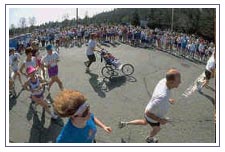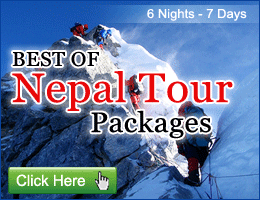
Himalayas
is a destination where one can find illusion as well as reality. The
potentially of the great Himalayas is an unexplained force which will tempt
travelers to visit and again.
Of course, India has its own resources for adventure sports. A running
event in high altitude is absolutely a thrilling experience and a new
concept to Asian sports, it is First Asian country where multi-day state
race in high altitude is being organized as an annual event. With fun and
thrill, it gives a once-in-a lifetime experience.
The Himalayan 100-mile Stage Race
It is a 5 days stage run in the high
Himalayas at an altitude varying between 6,600 to 11,815 ft. There are no
specific rules, age bar, and stage cut-off time. Anyone, physically fit and
interested can take part. The speed in running depends upon the individual
runners. They can run or they can just walk.
Running Stages
The run is designed for five days of 24-20-26-13-17 miles.
At each overnight stop participant are accommodated in rustic mountain huts
with delicious meals. The route itinerary is stream lined with stocked aid
stations including medical (doctor) facilities.
Running On Various Altitudes
Each day's running takes place at
different altitude. The running starts at 6,600 ft. up to 11,815 ft. On
second stage again up to 11,815 ft. While on third stage one can view Nepal
to the West, it starts from 11,815 ft. and finish at Rimbick at 6,350 ft.
Again fourth and fifth stage will go 8,555 ft then down to 6,600 ft. The
view of 4 out of 5 world's highest peaks is an enchanting experience.
The Mt. Everest Challenge Marthon
The first annual ECM took place in
1995 at Sandakphu. This sets a comfortable pace of allowing acclimatization
days to relax and enjoys spectacular views of Mt. Everest and Kanchenjunga
at Sandakphu National Park. The marathon is run on a ridgeline footpath
between 11,815 ft to 11,380 ft. from Sandakphu and back. The views of Nepal
to the West, Sikkim to the north and Darjeeling to the east appear around
run.
World's Most Beautiful Marathon
Each event is an environment
mission and presents the message of Himalayan conservation. In October 1993,
Mr. Bill Antholine, a professional environmentalist from USA, prepared
Guidelines and Questionnaires relating to the Stage Race, distributed to its
participants and asked to complete Questionnaires. In 1994 Mr. Antoline
completed a 140 page Eco Travel Case Study and presented to Indian Tourism
Officials and others concerned with conservation around the world. The study
highlights that Eco - tourism can be defined as purposeful travel that
creates an understanding of culture and natural history while safeguarding
the integrity of the ecosystem and producing local economic benefits that
encourage conservation.






 Himalayas
is a destination where one can find illusion as well as reality. The
potentially of the great Himalayas is an unexplained force which will tempt
travelers to visit and again.
Himalayas
is a destination where one can find illusion as well as reality. The
potentially of the great Himalayas is an unexplained force which will tempt
travelers to visit and again.